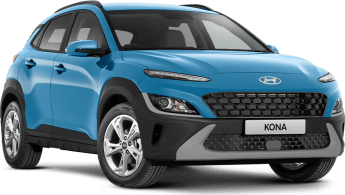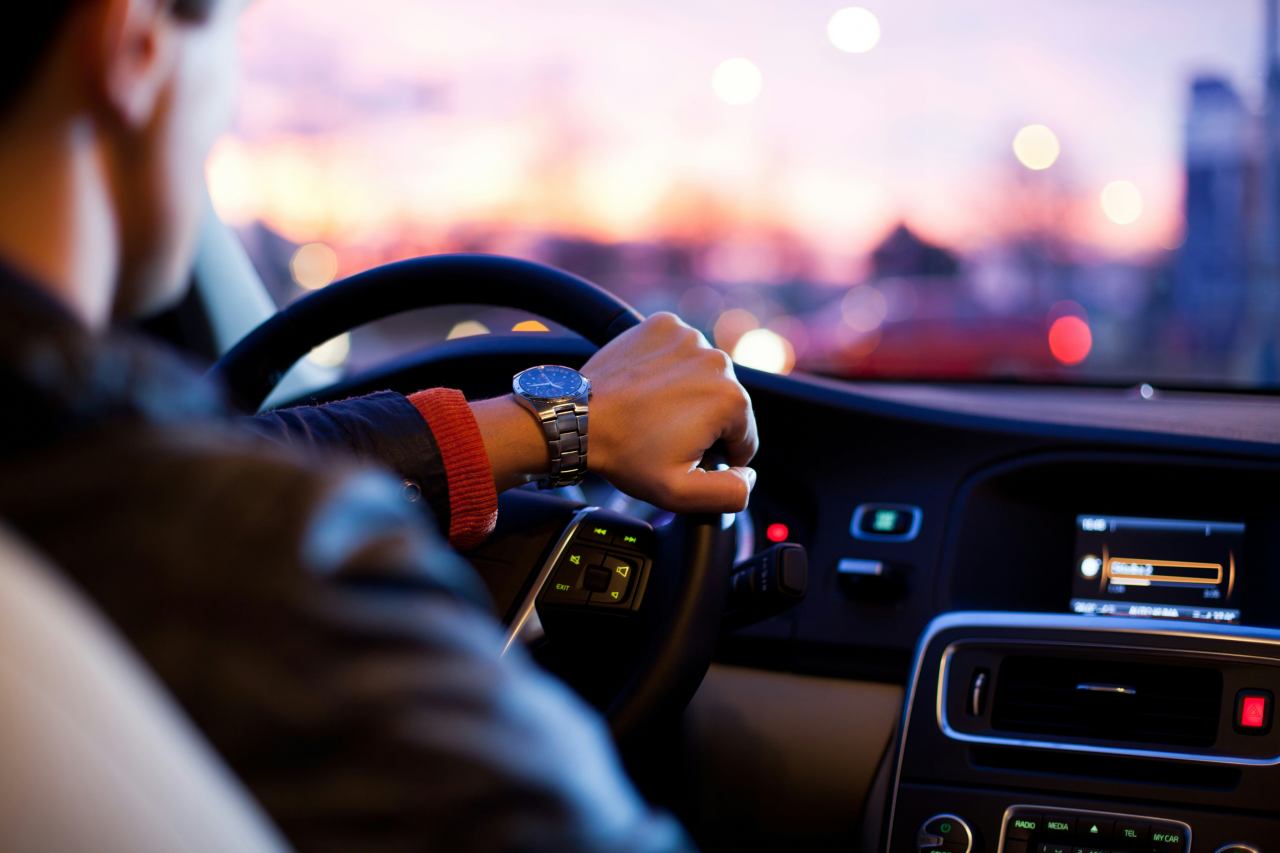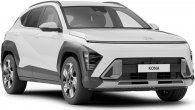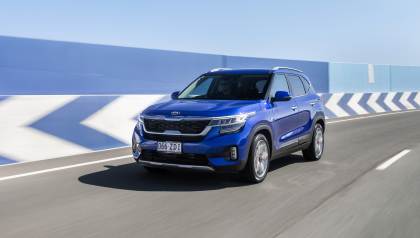The demise of the old Accent in 2019 left us with very few disappointing Hyundais – with the previous (2017-2021) Kona being one of them.
A busy ride, lots of noise and cheap bits inside made the divisively designed crossover feel way less than the sum of its parts, which happened to be based on the competent i30 hatchback. Despite striking styling, something certainly was lost in translation from small car to small SUV.

Now, 2021 ushers in a substantially changed Kona, brandishing a restyled snout, revised interior and platform modifications. Predictably, prices rise, by almost 10 per cent on the lowest grade. Additionally, it now costs upwards of $9000 to obtain the technically superior turbo/all-wheel drive with independent rear suspension upgrade, since this specification is now only available in the (admittedly highly-equipped) sporty N-Line, instead of being a circa-$3000 option across the range as previously. Yes, today’s Kona line-up is now simplified.
We assess the costliest (non-electric) front-drive version, the Highlander 2.0-litre naturally-aspirated model from $38,000 before on-road costs (representing a modest $1340 jump), because this was the Kona that felt most out if its depth in the old model.
Have the 2021 changes gone far enough? Is Hyundai’s popular small SUV now something worth saving up for? Read on to find out…
Hyundai Kona 2020: Highlander S.roof (fwd)
| Engine Type | Inline 4, 2.0L |
|---|---|
| Fuel Type | Unleaded Petrol |
| Fuel Efficiency | 7.2L/100km (combined) |
| Seating | 5 |
| Price From | $23,650 - $29,150 |
| Safety Rating |
|
Does it represent good value for the price? What features does it come with?
Briefly, along with fresh styling and a revised platform, the 2021 Kona 2.0L gains an overhauled powertrain.
Still part of the old ‘Nu’ family, the engine has evolved into the more-efficient ‘Smartstream’ series, making the same power and torque but providing superior fuel economy. It gains a CVT continuously variable transmission as well, in place of the previous six-speed torque-converter automatic transmission.
Hyundai has also meddled with the packaging, to create an extra 40mm of length, that’s said to benefit rear legroom and cargo capacity.
If you choose a base Kona from $26,600 (before ORC) you’ll find the usual goodies, like a large centre touchscreen, Bluetooth connectivity, Apple CarPlay/Android Auto compatibility, alloy wheels and roof rails. But you may not expect a wireless charging pad, electric park brake, ‘Quiet’ mode for the audio system (cutting sound to the rear speakers for resting travellers), a rear-seat USB charge port or two front-seat height adjusters. These help justify that near-10 per cent price hike.

Going Active for another $1600 adds niceties like heated mirrors, leather upholstery, rear privacy glass, solar control glass and rear-seat centre armrest with cupholders, while the $31,600 Elite introduces keyless entry/start, remote start function, climate control, a 10.25-inch touchscreen upsize (up from eight inches – and why do car companies not measure this in metric?), satellite navigation, an eight-speaker Harmon Kardon audio upgrade, front fog lights, acoustic film windscreen to cut noise and ritzier exterior trimmings.
Now, the $38,000 Highlander of course scores all these plus a head-up display, front parking sensors, heated, vented and powered front seats, a heated steering wheel, electro-chromatic interior mirror, LED headlights, sunroof and two-tone roof, as well as ambient lighting, digitised instrumentation, heated outboard rear seats and 18-inch machined-finish alloys shod with (quality) Continental tyres.
The last four items are new to the grade, along with an upgrade to the latest and improved versions of Hyundai’s driver-assist safety tech.

Highlander scores the lot, including Autonomous Emergency Braking (AEB) – now operational between 30km/h and 180km/h, blind-spot alert/avoidance, rear cross-traffic alert/assist, lane keep alert/assist, driver fatigue alert, adaptive cruise control with full stop/go, safe exit warning, leading vehicle departure alert and rear occupant alert; you'll also find six airbags, electronic stability control, anti-lock brakes with Brake Assist and electronic brake-force distribution, downhill brake control, hill-start assist, tyre pressure monitors, parking sensors all round, rear view camera, dusk-sensing headlights, auto high beams and rain-sensing wipers.
Not much left to option up, then, meaning the Highlander remains competitive with key front-drive rivals in terms of pricing versus kit, managing to just undercut the likes of the Mitsubishi Eclipse Cross Exceed ($38,290), Nissan Qashqai Ti ($39,090) and Mazda CX-30 Astina ($39,190), while cheaper alternatives such as the soon-to-be-completely-redesigned Honda HR-V VTi-LX ($36,950), Toyota C-HR Koba ($35,165) and related Kia Seltos Sport+ 2.0L ($33,290) aren’t quite as fully laden as this Kona.
Note, however, that the last two opponents are also offered with appealing hybrid and turbo/AWD upgrades respectively, and that still come in under the Highlander to boot. Adding the latter to the Kona equivalent (N-Line Premium) pushes it past $42K.
Finally, specifying premium/metallic paint costs $595 extra.
Is there anything interesting about its design?
If nothing else, the Kona is a showy piece of kit. So, how altered is new over old? More than the facelift title might suggest.
Gone is the old nose’s triple-layered lighting and grille treatments dominated by a hexagonal grille and large H-oval, for a sleeker if also fussy twin-grille design, but still with a trio of completely contrasting all-LED clusters, giving the 2021version a somewhat perma-smile look that some people prefer but others may find gormless.

Polished alloy wheels and a reshaped rear bumper complete the visual changes outside, while the Highlander grade boasts the aforementioned digital instrumentation, big 10.25-inch touchscreen and higher-quality interior trimmings.
Size-wise, the Kona still seems a little squeezy for its pricing and positioning, feeling not that much bigger than the boxy but roomy Venue, yet quite a lot littler than the larger new Tucson. It remains a fairly tightly packaged small SUV, and in some eyes, lacks the style-driven appeal of more coupe-like crossovers such as the CX-30 and C-HR.

How practical is the space inside?
The Kona isn’t as spacious as you might expect of an SUV based on the i30. It’s not bad, but the Seltos seems to have it licked dimensionally, feeling way roomier. Indeed, a HR-V, too, seems larger, lighter and airier inside.
But in Highlander guise at least, the little luxury touches and improvements to the quality of materials fitted do make for a more-convincing (and certainly better equipped) crossover.
You might not be a fan of the $275 beige perforated leather seats and matching lower-dash and door-card contrasts upgrade (that have a supernatural ability to attract dirt and grime), but it looks premium, with a head-up display (albeit on an old-fashioned plastic screen that rises from behind the binnacle), leather-clad wheel, electrically-adjustable vented and heated front seats, toasty rear outboard seats and large touchscreen.
But while the MY21 changes have brought the modish electronic instrument display, it only changes in colour and not in design or layout of the dials, meaning the whole set-up seems a bit half-baked compared to, say, a Peugeot or VW equivalent. In fact, the whole dash is now looking old and derivative, betraying the Kona’s advancing age. In default white ‘normal’ mode, the speedo and tacho combo are reminiscent of the 2002 Corolla’s.
Never mind. The Highlander’s squishy front seats are really quite comfy, with plenty of support (including lumbar) over longer distances, backed up with the aforementioned powered adjustability (including for height) on both sides, for added luxury appeal. Most rivals – hello Toyota – seem to forget about providing the latter functionality for the front passenger on higher series grades.

There are no complaints about the Kona’s driving position, either. A fine relationship exists between the operator and nicely-grippy steering wheel, that also adjusts of course for both reach and height to provide an unencumbered view of those not-so-new looking dials. Ventilation is first class, there’s sufficient storage for most small items (including a larger bottle in the door pockets), and once you familiarise yourself with the various scattered buttons around the console, they’re in easy reach. Nothing at all intimidating here.

Rear-seat entry is surprisingly good, and there’s ample space for two 178cm-tall people sat behind a same-sized driver and passenger. The backrest is fixed but well placed, while the cushion is sufficiently comfy over short distances.
If you’re game a third person can just fit in between but it will be tight and hair or scalp will scrape the Kona’s ceiling. There’s plenty of storage, a single USB outlet, overhead grab handles, reading lights, a centre armrest with cupholders and one map pocket.

But the boot remains shallow and small for the size of the Kona even though there are improvements to be gleaned here, with a high floor over a space-saver spare reducing normal capacity to just 374 litres (it was 13L less pre-facelift). There isn’t much in the way of versatility either, beyond the prerequisite split/folding rear backrest. Doing this ups the load area availability to 1156L. Nothing slides or removes, unlike a Skoda Karoq's divided trio of rear seats.

All-up, then, the Highlander’s interior is compact, extremely well-screwed together, and of acceptable quality, without a squeak or rattle to be heard. It’s also quieter than before, but there’s no denying that it’s beginning to seem old and dated now, despite the changes brought in by the facelift.
Speaking of which, let’s look underneath the bonnet.
What are the key stats for the engine and transmission?
The 1999cc 2.0-litre Nu Smartstream features twin cams, 16 valves, dual continuously variable valve timing and a new Atkinson cycle combustion process and two-step variable induction system, to dramatically improve fuel efficiency. More on that a little later.

A maximum of 110kW of power at 6200rpm and 180Nm of torque at 4500rpm is delivered to the front wheels via a CVT, while the latter’s sequential ‘manual’ mode offers what Hyundai calls eight “virtual” gears, accessible with a push forward to go up and a pull of the lever back to go down. We wouldn't bother.
Weighing in at a hefty 1383kg (kerb), the Highlander’s power-to-weight ratio is 79.5kW per tonne.
Why CVT? For a claimed 14 per cent drop in fuel consumption compared to before.
How much fuel does it consume?
The old Kona 2.0L FWD was not a very economical engine, so the move to the new combustion process and CVT promised advances. And, for once, the end result did not let us down.
Hyundai claims a combined average of 6.2 litres per 100km – or 8.3L/100km around town and a frankly-outstanding 5.0L/100km in the extra-urban route – for a carbon dioxide emissions average of 148 grams per kilometre. Fitted with a 50L fuel tank, this means a theoretical 800km-plus range between top-ups.

We managed an entirely reasonable 7.4L/100km at the pump. That was a mix of air-con-on two-person inner-city high-density traffic commuting, open-road cruising and some very spirited performance testing. Not bad at all.
This Kona will run on 91 RON standard unleaded as well as a 94 RON E10 ethanol mixture.
Warranty & Safety Rating
What safety equipment is fitted? What safety rating?
Tested in 2017, the Kona scored a five-star ANCAP crash-test rating.
On the driver-assist tech front, you’ll find Autonomous Emergency Braking (AEB – operational between 30km/h and 180km/h), blind-spot alert/avoidance, rear cross-traffic alert/assist, lane keep alert/assist, driver fatigue alert, adaptive cruise control with full stop/go, safe exit warning (excellent for not dooring passing cyclists), leading vehicle departure alert and rear occupant alert.

Also fitted are six airbags (dual front, side and head items), electronic stability control, anti-lock brakes with Brake Assist and electronic brake-force distribution, downhill brake control, hill-start assist, tyre pressure monitors, rear parking sensors, rear view camera, dusk-sensing headlights, auto high beams, rain-sensing wipers and rollover sensors.
Two rear-seat ISOFIX points as well as a trio of top tethers for straps are included for younger passengers.
What does it cost to own? What warranty is offered?
Hyundai offers a five-year/unlimited kilometre warranty as well as 12 months of roadside assistance, with scheduled servicing at every 12-month or 15,000km intervals.
Published online, the prices for the N-Line service is $319 for each of the first five annual services, then rises to $380 (year six), $305 (year seven), $370 (year eight), $320 (year eight), $365 (year nine) and $660 (year 10). Accurate at the time of publishing, prices vary after that – between $275 and $380 – right up to the 51-year/510,000km service mark!
What's it like to drive around town?
That’s much better.
Unlike the previous, bouncy Kona, our Series II Highlander is smoother, quieter and more civilised, but still quite punchy. It’s like driving the old version but with ear muffs on. We wonder how much of that is down to the better-quality tyres, since the Australian road tuning that Hyundai undertook in 2017 carries over. There are no changes to the MacPherson strut front and torsion beam rear suspension set-up, as far as we can ascertain.
Additionally, you might think that swapping out a six-speed torque-converter auto for a CVT might detract from the driving experience enjoyment. But, surprisingly, no. The latter works especially well with the 2.0L engine. Acceleration from standstill is instant and smooth – if still a bit on the loud side – with speed building up strongly as required. The old boomy exhaust is gone, though you’d never mistake the sound the Smartstream emits for, say, a Honda VTEC unit.

That local Aussie tune continues to pay dividends whether you’re happy to potter about town, schlepp to and from work on a boring old motorway or power up a mountain road. From a steering and handling point of view, it’s difficult to fault the Highlander on Continental PremiumContact6 235/45R18 rubber. Even on damp roads, it corners faithfully, holds it line as requested and isn’t prone to rack rattle or bump-steer. This is progress, folks. The old Kona was a groaner in such conditions.
Plus, there’s a reassuring feeling of control and feedback from the way the Hyundai corners so confidently, making it a good choice if you’re a keen driver. If you're in the mood, the Kona will grow a set of horns and come out to play.
And while the ride is still too firm around town, it’s nowhere near as punishing, or as jittery, as before. The whole chassis set-up is more in keeping with the Highlander’s upmarket positioning. We’re not saying it’s the last word in refinement or quietness – take a spin in a C-HR or Peugeot 3008 if you want to experience real suspension suppleness – but the revamped Kona is definitely improved.
Coarse highways still send an ever-present drone through to the cabin, though, and like we said, bumps and potholes are still very definitely felt.
Back in the urban jungle, the Kona’s compact dimensions, light steering, big mirrors and helpfully large camera screen make parking this a doddle. It’s easy to place, a cinch for manoeuvrability and responsive enough to throttle requests for zipping into traffic gaps.
Overall, then, big steps forward for Hyundai's small SUV, though the class best like the CX-30 can still rest easy.
Verdict
If there was one small SUV that needed improvement, then that’s the old Hyundai Kona. And job well done. The Highlander is now a well-equipped, economical, easy to drive, safe and dynamically capable example of its crossover breed.
But is it class leading? No, far from it. Are there still issues? Urban streetscape and rough-road ride comfort remains poor, there isn’t as much space or versatility as the Highlander’s hefty $38,000 price tag suggests and the styling is starting to tired, especially inside.
So, the latest Kona goes from a segment straggler to a solid mid-field contender. If you like what you see and can see past the failings, then by all means… enjoy. It's finally the small SUV Hyundai should have launched back in 2017.
Pricing Guides







.jpg)








.png)








.jpg)


.jpg)



.jpg)

.jpg)


Comments